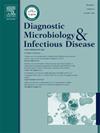内脏利什曼病的诊断技术:东非使用的方法概述。
IF 2.1
4区 医学
Q3 INFECTIOUS DISEASES
Diagnostic microbiology and infectious disease
Pub Date : 2024-12-14
DOI:10.1016/j.diagmicrobio.2024.116655
引用次数: 0
摘要
利什曼病是一种由利什曼属原生动物引起的寄生虫感染,由旧大陆的沙蝇、白蛉和新大陆的卢茨米亚蝇传播。这种疾病在热带、亚热带和南欧流行,每年影响约150万至200万人。印度、孟加拉国、苏丹、南苏丹、巴西和埃塞俄比亚占所有VL病例的90%。虽然亚洲的利什曼原虫病例正在减少,但东非,特别是索马里、苏丹、南苏丹、埃塞俄比亚和肯尼亚的病例却在增加。东非病例增加的部分原因是持续的武装冲突,特别是在索马里、苏丹和苏丹南部,这些冲突使人们流离失所,并增加了他们受到沙蝇叮咬的机会。从流行地区向非流行地区的移徙、误诊、饥荒、营养不良、气候变化和艾滋病毒病例增加是其他促成因素。东非利什曼原虫的临床诊断将患者的临床症状与血清学或寄生虫学检测相结合,使用的主要方法是rK39试纸和显微镜。该病的诊断仍然具有挑战性,因为目前的技术存在局限性,包括无法检测组织中的寄生虫,需要专业知识,检测设备的成本过高,抗体滴度低,以及由于与艾滋病毒、结核病、疟疾和伤寒等疾病合并感染而导致误诊的风险。包括血清学和分子寄生虫学方法在内的各种技术已被用于尝试解决这些挑战,但成功有限。因此,本文综述了在东非利什曼原虫诊断中使用的一些技术,并讨论了其他可用的新技术,目的是克服当前的挑战。本文章由计算机程序翻译,如有差异,请以英文原文为准。
Diagnostic techniques for visceral leishmaniasis: An overview of methods used in East Africa
Leishmanias is a parasitic infection caused by a protozoan belonging to the genus Leishmania and transmitted by sand fly, Phlebotomus fly in the old world and Lutzomyia in the New world. The disease is prevalent in the tropics, subtropics, and Southern Europe, where it affects about 1.5 million to 2 million people annually. India, Bangladesh, Sudan, South Sudan, Brazil and Ethiopia account for up to 90% of all the VL cases. While Leishmania cases in Asia are declining, cases in East Africa especially in Somalia, Sudan, South Sudan, Ethiopia and Kenya have been increasing. The rise in East African cases is partially attributed to ongoing armed conflicts especially in Somalia, Sudan and Southern Sudan, which has displaced people and increased their exposure to sand fly bites. Migration from endemic to non-endemic regions, misdiagnosis, famine, malnutrition, climate change and an increase in HIV cases are other contributing factors. The clinical diagnosis of Leishmania in East Africa combines the patient's clinical signs with either serological or parasitological test, with rK39 strip and microscopy being the major methods used. Diagnosis of the condition remains challenging, as current techniques have limitations, including the inability to detect parasites in tissue, the need for specialized expertise, prohibitive costs of testing equipment, low antibody titers, and the risk of misdiagnosis due to co-infections with diseases such as HIV, tuberculosis, malaria and typhoid. Various techniques, including serological and molecular parasitological methods, have been employed in attempts to address these challenges, but with limited success. This article therefore, reviews some of the techniques that have been used in Leishmania diagnosis in East Africa and discusses other available new techniques with aim of overcoming the current challenges.
求助全文
通过发布文献求助,成功后即可免费获取论文全文。
去求助
来源期刊
CiteScore
5.30
自引率
3.40%
发文量
149
审稿时长
56 days
期刊介绍:
Diagnostic Microbiology and Infectious Disease keeps you informed of the latest developments in clinical microbiology and the diagnosis and treatment of infectious diseases. Packed with rigorously peer-reviewed articles and studies in bacteriology, immunology, immunoserology, infectious diseases, mycology, parasitology, and virology, the journal examines new procedures, unusual cases, controversial issues, and important new literature. Diagnostic Microbiology and Infectious Disease distinguished independent editorial board, consisting of experts from many medical specialties, ensures you extensive and authoritative coverage.

 求助内容:
求助内容: 应助结果提醒方式:
应助结果提醒方式:


